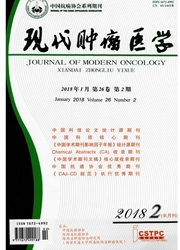

 中文摘要:
中文摘要:
目的:通过探讨肺腺癌成纤维细胞活化蛋白α(FAPα)的表达与腺癌中临床病理因素的相关性,评价FAP α在腺癌中的表达意义.方法:选取经病理准确诊断为腺癌的肺癌患者85例,应用免疫组织化学方法检测腺癌组织FAP α的表达,收集腺癌患者的临床病理信息,分析FAPα与肺腺癌临床病理因素表达水平之间的关系.结果:FAPα主要表达在肺腺癌间质中基质成纤维细胞中,正常对照肺组织及腺癌细胞中均未检测到FAP α表达.脉管浸润阳性组FAP α表达阳性率明显高于无脉管浸润组(U=512.500,P=0.004),伴淋巴结转移组FAP α表达阳性率明显高于无淋巴结转移组(U=670.500,P=0.040),FAP α表达与肿瘤长径呈显著正相关(r =0.307,P=0.004),FAPα表达与临床分期呈显著正相关(r=0.232,P=0.033);FAP α的表达与患者年龄(r=-0.139,P=0.204)、性别(P=0.419)、肿瘤位置(U=338.000,P=0.091)无关.结论:FAP α在肺腺癌早期发生、发展、侵袭转移方面起到了重要的作用,可能作为肺腺癌诊断及治疗的潜在靶点.
 英文摘要:
英文摘要:
Objective:To investigate the expression and value of fibroblast activation protein α (FAP α) in lung adenocarcinoma.Methods:The expression of 85 cases with lung adenocarcinoma was evaluated with the immunohistochemical stain.We collected patients's clinicopathological information and analyzed the relationship of FAP α and clinicopathological factors.Results:FAP α positively expressed in the tumor-associated fibroblasts and there was no FAP α expression in the normal lung tissue and in adenocarcinoma.FAP α expression positive rate in vascular invasion positive group was significantly higher than those without vascular invasion group (U =512.500,P =0.004).FAP o expression positive rate with lymph node metastasis group was significantly higher than that of without lymph node metastasis (U =670.500,P =0.040).FAP α expression was positively correlated with tumor size (r =0.307,P =0.004),FAP α expression was positively correlated with clinical stage(r =0.232,P =0.033).There was no correlation between the expression of FAP α and the age of the patients (r =-0.139,P =0.204),gender(P =0.419),tumor location(U =338.000,P =0.091).Conclusion:FAP α express in lung adenocarcinoma and may serve as a new potential therapeutic targets for early tumor.
 同期刊论文项目
同期刊论文项目
 同项目期刊论文
同项目期刊论文
 Identification of novel low molecular weight serum peptidome biomarkers for non-small cell lung canc
Identification of novel low molecular weight serum peptidome biomarkers for non-small cell lung canc 期刊信息
期刊信息
